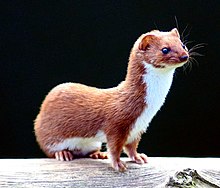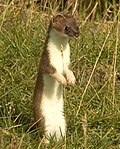Weasel
| Weasel | |
|---|---|

| |
| Least weaselin England | |
| Scientific classification | |
| Domain: | Eukaryota |
| Kingdom: | Animalia |
| Phylum: | Chordata |
| Class: | Mammalia |
| Order: | Carnivora |
| Family: | Mustelidae |
| Subfamily: | Mustelinae |
| Genus: | Mustela Linnaeus,1758 |
| Type species | |
| Mustela erminea | |
| Species | |
| |

| |
| Mustelarange | |
Weasels/ˈwiːzəlz/aremammalsof thegenusMustelaof thefamilyMustelidae.The genusMustelaincludes theleast weasels,polecats,stoats,ferrets,andEuropean mink.Members of this genus are small, active predators, with long and slender bodies and short legs. The family Mustelidae, or mustelids (which also includesbadgers,otters,andwolverines), is often referred to as the "weasel family". In the UK, the term "weasel" usually refers to the smallestspecies,theleast weasel(M. nivalis),[1]the smallestcarnivoranspecies.[2]
Least weasels vary in length from173 to 217 mm (6+3⁄4to8+1⁄2in),[3]females being smaller than the males, and usually have red or brown upper coats and white bellies; some populations of some speciesmoultto a wholly white coat in winter. They have long, slender bodies, which enable them to follow their prey into burrows. Their tails may be from34 to 52 mm (1+1⁄4to 2 in) long.[3]
Weasels feed on small mammals and have from time to time been consideredverminbecause some species tookpoultryfrom farms orrabbitsfrom commercial warrens. They do, on the other hand, eat large numbers ofrodents.Their range spansEurope,North America,much ofAsiaandSouth America,and small areas inNorth Africa.
Terminology
The English word "weasel" was originally applied to onespeciesof thegenus,the European form of theleast weasel(Mustela nivalis). This usage is retained inBritish English,where the name is also extended to cover several other small species of the genus. However, in technical discourse and in American usage, the term "weasel" can refer to any member of the genus, the genus as a whole, and even to members of the related genusNeogale.Of the 16 extant species currently classified in the genusMustela,10 have "weasel" in their common names. Among those that do not are the three species of ermine,[* 1]thepolecats,theferret,and theEuropean mink.[4]: 12
TheAmerican minkand the extinctsea minkwere commonly included in this genus asMustela visonandMustela macrodon,respectively, but in 1999 they were moved to the genusNeovison.[5]In 2021, bothNeovisonspecies, along with thelong-tailed weasel(Mustela frenata),Amazon weasel(Mustela africana) andColombian weasel(Mustela felipei) were moved to the genusNeogale,as the clade containing these five species was found to be fully distinct fromMustela.[6]
Taxonomy
The genus nameMustelacomes from the Latin word for weasel combining the wordsmusmeaning "mouse" andtelummeaning "javelin" for its long body.[4]: 3
Species
The following information is according to theIntegrated Taxonomic Information SystemandMammalDiversity.
| Image | Scientific name | Common name | Distribution |
|---|---|---|---|
 |
Mustela altaicaPallas, 1811 | Mountain weasel | NorthernandSouthern Asia |
| Mustela lutreolinaRobinson and Thomas, 1917 | Indonesian mountain weasel | Southern Asia | |
 |
Mustela ermineaLinnaeus, 1758 | Stoat,Beringian ermine, Eurasian ermine, or short-tailed weasel |
Europe and Northern Asia ArcticCanadaandAlaska(United States) Southern Asia (non-native) New Zealand (non-native) |
 |
Mustela nivalisLinnaeus, 1766 | Least weasel | Europe,North Africaand Northern Asia North America Southern Asia (non-native) New Zealand (non-native) |
| Mustela aistoodonnivalisWu & Kao, 1991 | Missing-toothed pygmy weasel | ShaanxiandSichuan,China | |

|
Mustela richardsoniiBonaparte, 1838 | American ermine | Most of North America south of Alaska and the Arctic Circle; eastern Nunavut and Baffin Island |

|
Mustela haidarumPreble, 1898 | Haida ermine | Haida Gwaii(British Columbia,Canada) andAlexander Archipelago(Alaska, United States) |
 |
Mustela eversmanii(Lesson, 1827) | Steppe polecat | Southeast Europe and Northern Asia Southern Asia |

|
Mustela furoLinnaeus, 1758 | Domestic ferret | Domestic
Worldwide (domesticated); New Zealand (non-native) |
 |
Mustela putoriusLinnaeus, 1758 | European polecat | Europe,North Africaand Northern Asia |
 |
Mustela itatsiTemminck, 1844 | Japanese weasel | Japan and formerlySakhalin Island,Russia |
 |
Mustela sibiricaPallas, 1773 | Siberian weasel | Europe and Northern Asia Southern Asia |
 |
Mustela kathiahHodgson, 1835 | Yellow-bellied weasel | Southern Asia |
 |
Mustela lutreola(Linnaeus, 1761) | European mink | Europe |
 |
Mustela nigripes(Audubon and Bachman, 1851) | Black-footed ferret | North America |
| Mustela nudipesDesmarest, 1822 | Malayan weasel | Southern Asia | |
 |
Mustela strigidorsaGray, 1855 | Back-striped weasel | Southern Asia |
1Europe and Northern Asia division excludes China.
Cultural meanings
Weasels have been assigned a variety of cultural meanings.
InGreek culture,a weasel near one's house is a sign of bad luck, even evil, "especially if there is in the household a girl about to be married", since the animal (based on its Greek etymology) was thought to be an unhappy bride who was transformed into a weasel[7]and consequently delights in destroying wedding dresses.[8]InMacedonia,however, weasels are generally seen as an omen of good fortune.[7][8]
Inearly-modernMecklenburg,Germany, amulets from weasels were deemed to have strong magic; the period between 15 August and 8 September was specifically designated for the killing of weasels.[9]: 255
InMontagne Noire(France),Ruthenia,and theearly medievalculture of theWends,weasels were not meant to be killed.[9]
According toDaniel Defoealso, meeting a weasel is a bad omen.[10]In English-speaking areas, weasel can be an insult, noun or verb, for someone regarded as sneaky, conniving or untrustworthy. Similarly, "weasel words"is a critical term for words or phrasing that are vague, misleading or equivocal.
Japanese superstitions


In Japan, weasels(Chồn sóc, chồn sóc chuột,itachi)were seen asyōkai(causing strange occurrences). According to the encyclopediaWakan Sansai Zuefrom theEdo period,a pack of weasels would cause conflagrations, and the cry of a weasel was considered a harbinger of misfortune. In theNiigata Prefecture,the sound of a pack of weasels making a rustle resembled six people hulling rice, so was called the "weasel's six-person mortar", and it was an omen for one's home to decline or flourish. It is said that when people chase after this sound, the sound stops.[11]
They are also said to shapeshift like the fox (kitsune) ortanuki,and thenyūdō-bōzutold about in legends in theTōhoku regionand theChūbu regionare considered weasels in disguise, and they are also said to shapeshift intoōnyūdōand little monks.[11]
In the collection of depictionsGazu Hyakki YagyōbySekien Toriyama,they were depicted under the title chồn sóc, but they were read not as "itachi",but rather as"ten",[12]and "ten" were considered to be weasels that have reached one hundred years of age and became yōkai that possessed supernatural powers.[13]Another theory is that when weasels reach several hundred years of age, they becomemujina(Japanese badgers).[14]
In Japanese, weasels are callediizunaorizuna(Cơm cương)and in theTōhoku RegionandShinshu,it was believed that there were families that were able to use a certain practice to freely usekudagitsuneasiizuna-tsukaiorkitsune-mochi.It is said thatMount Iizuna,from theNagano Prefecture,got its name due to how the gods gave people mastery of this technique from there.[15]
According to thefolkloristMutō Tetsujō,"They are calledizunain theSenboku District,[* 2]Akita Prefecture,and there are also the ichiko (itako) that use them. "[16]Also, in theKitaakita District,they are calledmōsuke( mãnh trợ ), and they are feared asyōkaieven more than foxes (kitsune).[16]
In theAinu language,ermines are calledupas-čironnuporsáčiri,but since least weasels are also calledsáčiri,Mashio Chirisurmised that the honorary titlepoy-sáčiri-kamuy(wherepoymeans "small" ) refers to least weasels.[17]
Kamaitachi
Kamaitachiis a phenomenon wherein one who is idle is suddenly injured as if his or her skin were cut by a scythe. In the past, this was thought to be "the deed of an invisibleyōkaiweasel ". An alternate theory, asserts thatkamaitachiis derived fromkamae Tachi(Cấu え thái đao,"stance sword" ),so were not originally related to weasels at all.[18]
See also
Notes
- ^These three species areMustela erminea,(theEurasian ermineor stoat);M. haidarum,(theHaida ermine); andM. richardsonii,(theAmerican ermine).
- ^However, in the Senboku District, especially in Obonai village(Sinh bảo nội thôn),they are calledokojo.[16]
References
- ^Shorter Oxford English dictionary.United Kingdom: Oxford University Press. 2007. p. 3804.ISBN978-0199206872.
- ^Valkenburgh, Blaire Van; Wayne, Robert K. (9 November 2010)."Carnivores".Current Biology.20(21): R915–R919.Bibcode:2010CBio...20.R915V.doi:10.1016/j.cub.2010.09.013.ISSN0960-9822.PMID21056828.S2CID235312150.
- ^ab"The Weasel".The Mammal Society.Retrieved11 April2017.
- ^abKing, Carolyn M.; Powell, Roger A. (2006).The Natural History of Weasels and Stoats: Ecology, Behavior, and Management.Oxford University Press.ISBN978-0-19-804113-9.
- ^Abramov, A.V. 1999. A taxonomic review of the genusMustela(Mammalia, Carnivora).Zoosystematica Rossica,8(2): 357-364
- ^Patterson, Bruce D.; Ramírez-Chaves, Héctor E.; Vilela, Júlio F.; Soares, André E. R.; Grewe, Felix (2021)."On the nomenclature of the American clade of weasels (Carnivora: Mustelidae)".Journal of Animal Diversity.3(2): 1–8.doi:10.52547/JAD.2021.3.2.1.ISSN2676-685X.S2CID236299740.
- ^abLawson, John Cuthbert (2012).Modern Greek Folklore and Ancient Greek Religion: A Study in Survivals.Cambridge UP. pp. 327–28.ISBN978-1-107-67703-6.
- ^abAbbott, George Frederick (1903).Macedonian folklore.Cambridge UP. pp.108–109.Retrieved13 February2012.
- ^abThomas, N.W. (September 1900)."Animal Superstitions and Totemism".Folk-lore.11(3): 228–67.doi:10.1080/0015587X.1900.9719953.JSTOR1253113.
- ^Hazlitt, William Carew; Brand, John (1905).Faiths and folklore: a dictionary of national beliefs, superstitions and popular customs, past and current, with their classical and foreign analogues, described and illustrated.Reeves and Turner. p.622.Retrieved13 February2012.
- ^abThôn thượng kiện tư biên 『 yêu quái sự điển 』 mỗi ngày tin tức xã, 2000 năm, 36 trang.ISBN978-4-6203-1428-0.
- ^Cao điền vệ giam tu đạo điền hết lòng tin theo ・ điền trung thẳng ngày biên 『 điểu núi đá yến họa đồ bách quỷ dạ hành 』 quốc thư phát hành sẽ, 1992 năm, 50 trang.ISBN978-4-336-03386-4.
- ^Thiếu niên xã ・ trung thôn hữu kỷ phu ・ võ điền えり tử biên 『 yêu quái の bổn dị giới の ám に xuẩn く bách quỷ dạ hành の vân nói 』 học tập nghiên cứu xã 〈New sight mook〉, 1999 năm, 123 trang.ISBN978-4-05-602048-9.
- ^Dân dã xảo 『 ảo tưởng động vật sự điển 』 kỷ nguyên mới xã, 1997 năm, 30 trang.ISBN978-4-88317-283-2.
- ^『 quảng từ uyển đệ 4 bản 』(1991 năm ), nham sóng hiệu sách “いづなつかい【 cơm cương sử ・ cơm 縄 khiển 】” の hạng
- ^abcVõ đằng, thiết thành (1940),"Thu điền quận ấp cá đàm",アチックミユーゼアム hội báo,45:41–42,
Bắc thu điền ではモウスケと xưng して hồ より sợ がられ, tiên bắc địa phương ではイヅナと xưng し, それを sử う vu nữ (エチコ)もある. Tên khoa học コエゾイタチを, này の phó gần..〔 sinh bảo nội thôn 〕では..オコジョと vân ふ( điền khẩu cày chi trợ thị )
. - ^Biết, thật chí bảo (Chiri, Mashiho) (30 March 1959),"アイヌ ngữ thú danh tập (On the names of the mammals of the Ainu language)"(PDF),Hokkaido đại học văn học bộ kỷ yếu = the Annual Reports on Cultural Science:141,ISSN0437-6668,archived(PDF)from the original on 9 October 2022
{{citation}}:CS1 maint: multiple names: authors list (link) - ^Nhân văn xã biên tập bộ (2005).Chư quốc quái đàm chuyện lạ tổng thể giang hộ chư quốc trăm vật ngữ đông Nhật Bản biên.も の しりシリーズ. Nhân văn xã. p. 104.ISBN978-4-7959-1955-6.
Further reading
- Nowak, Ronald M., and Ernest P. Walker.Walker's Carnivores of the World.Baltimore:Johns Hopkins University Press,2005.ISBN0-8018-8033-5,ISBN0-8018-8032-7.
- C. Hart Merriam,Synopsis of the Weasels of North America,Washington, Government Printing Office, 1896.
- Angier, Natalie (13 June 2016)."Weasels Are Built for the Hunt".The New York Times.Retrieved15 June2016.







